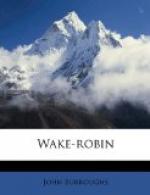I descend a steep hill, and approach the hemlocks through a large sugar-bush. When twenty rods distant, I hear all along the line of the forest the incessant warble of the red-eyed vireo, cheerful and happy as the merry whistle of a schoolboy. He is one of our most common and widely distributed birds. Approach any forest at any hour of the day, in any kind of weather, from May to August, in any of the Middle or Eastern districts, and the chances are that the first note you hear will be his. Rain or shine, before noon or after, in the deep forest or in the village grove,—when it is too hot for the thrushes or too cold and windy for the warblers,—it is never out of time or place for this little minstrel to indulge his cheerful strain. In the deep wilds of the Adirondacks, where few birds are seen and fewer heard, his note was almost constantly in my ear. Always busy, making it a point never to suspend for one moment his occupation to indulge his musical taste, his lay is that of industry and contentment. There is nothing plaintive or especially musical in his performance, but the sentiment expressed is eminently that of cheerfulness. Indeed, the songs of most birds have some human significance, which, I think, is the source of the delight we take in them. The song of the bobolink to me expresses hilarity; the song sparrow’s, faith; the bluebird’s, love; the catbird’s, pride; the white-eyed flycatcher’s, self-consciousness; that of the hermit thrush spiritual serenity: while there is something military in the call of the robin.
The red-eye is classed among the flycatchers by some writers, but is much more of a worm-eater, and has few of the traits or habits of the Muscicapa or the true Sylvia. He resembles somewhat the warbling vireo, and the two birds are often confounded by careless observers. Both warble in the same cheerful strain, but the latter more continuously and rapidly. The red-eye is a larger, slimmer bird, with a faint bluish crown, and a light line over the eye. His movements are peculiar. You may see him hopping among the limbs, exploring then under side of the leaves, peering to the right and left, now flitting a few feet, now hopping as many, and warbling incessantly, occasionally in a subdued tone, which sounds from a very indefinite distance. When he has found a worm to his liking, he turns lengthwise of the limb and and bruises its head with his beak before devouring it.
As I enter the woods the slate-colored snowbird starts up before me and chirps sharply. His protest when thus disturbed is almost metallic in its sharpness. He breeds here, and is not esteemed a snowbird at all, as he disappears at the near approach of winter, and returns again in spring, like the song sparrow, and is not in any way associated with the cold and snow. So different are the habits of birds in different localities. Even the crow does not winter here, and is seldom seen after December or before March.




